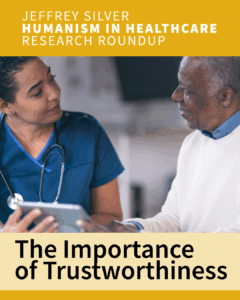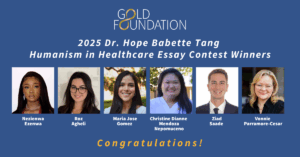by Johanna Shapiro PhD
 Many articles, panels and presentations have focused on questions regarding the relationships (if any) among the humanities, humanism, and professionalism. These questions may never be definitively answered (nor, perhaps should they be). Nevertheless, below I share some of my own in-progress thoughts that I hope add light not heat to this ongoing debate.
Many articles, panels and presentations have focused on questions regarding the relationships (if any) among the humanities, humanism, and professionalism. These questions may never be definitively answered (nor, perhaps should they be). Nevertheless, below I share some of my own in-progress thoughts that I hope add light not heat to this ongoing debate.
Professionalism itself is a contentious subject, with many competing definitions. However, to be meaningful, professionalism must, as Robert Coles knew, engage the moral imagination (ref 1). To me, the most important meta-questions a future physician can engage with (preferably every day of her life) are fundamentally moral ones :
- What kind of doctor do I want to be?
- Who am I and who can I become within the practice of medicine?
- How do dominant discourses in medicine and society influence me, my patients, and our community in negative or positive ways?
- What is my commitment/responsibility/ to my patients and my community and how can I best serve them?
Because of its moral dimension, professionalism inevitably implicates qualities of humanism such as integrity, compassion, altruism, empathy, and respect toward others (ref 2). In my understanding at least, these are not fixed, once-and-for-all achievable attributes in which one can be certified as having attained “competency.” Rather, they might better be conceived as ongoing and ever-evolving relational and interactional capacities and habits of mind that come into play in particularistic situations and are influenced by dimensions of race, class, culture, power, and privilege.
These comments still beg the question, what if anything do humanism and professionalism have to do with the humanities? Simply put (and I hope not simplistically) I have never found a better way of encouraging students to ask questions (including the ones above) and of stimulating a critical position in regards to the answers that emerge than by having them read a poem or participate in a skit or gaze at a painting. I do not believe that the use of literature and the arts in medical education should – or indeed can – “make” student physicians be either “humanistic” or “professional” in some reductive, utilitarian model (ref 3). They are not a mechanism for “producing” “professional” physicians, but instead facilitate a process in which students can examine what they think professionalism means; and encourage them to interrogate conventional wisdom about accepted virtues such as empathy and compassion (ref 4). The particularity and contextual groundedness of literature force a real-world engagement that appropriately activates emotions and passions as well as cognitions (ref 5) that can, and should, lead to social activism.
Learners interact with literature and the arts in many ways, all of which invoke Parker Palmer’s “third thing.” As discussed by Elizabeth Gaufberg and Maren Batalden (ref 6), Palmer’s phrase refers to a search for understanding not through the confrontation so favored in Western culture, but through indirection, through using a third thing such as a poem to mediate our grasp of the relationship between doctors and patients. As Lisa Zunshine points out, it is the implicit aspect of fiction that causes learners to work harder at actively reorganizing perceptions, making inferences, identifying multiple meanings, and generating complex interpretations (ref 7). Literature functions as “the third thing” that allows subjective viewpoints, associations, and insights to emerge safely and creatively but with intention and focus.
Some examples of literature as a third thing follow:
- Engaging with existing narratives, poetry, art and texts
One widespread way learners encounter literature is through engagement with existing narratives, poetry, art, and texts. Here, they focus attention not on themselves or their patients directly, but on stories or images of other patients and doctors or students. Yet through a guided facilitative process, they also make connections back to real life. Literature and art become “the third thing” that creates, in Emily Dickinson’s words, “truth at a slant.” (ref 8) - Turning to literature and art for their own inspiration, insight and healing
Learners can also turn to literature for their own inspiration, insight, and healing. This personal rebalancing is not unrelated to who they are as professionals and it too occurs through indirection. In this case, learners may seek only a “break” from the daily grind of studying or the demands and pressures of clinical care. Yet through reading about the experiences of others, their sense of alienation and isolation decreases, and their sense of community expands to include patients and physicians from other times, other cultures, and with other problems. Their compassion often expands as well, as through the “third thing” of literature or art they are able to put their own issues into perspective, as well as sometimes to discover new ways of thinking and being, relevant to their own personal and professional lives. - Creating their own literature and art
Finally, learners can actually create literature and art as a way of reflecting on patients and other professional encounters, as well as on their own lives and experiences in training. This practice too creates a “third thing” in the sense that the creative work now stands as something other, yet something related to, both the student and the patient, that has ties of emotion, insight, and understanding to both. Similar to reading about the experience of others, writing about their own experience also often reveals different perspectives and insights of which the learner was not initially aware.
In recent years, the term medical humanities has been the recipient of much (deserved) criticism and is increasingly unsatisfactory (ref 9). Part of the confusion and disagreement over the term arises, I think, because we are not always sure what it is we are doing with the humanities in medical education (and as noted earlier, that is not always a bad thing). But perhaps what is needed is a collection of terms under the large umbrella of “humanities” that honor its varied and multiple capacities. In this regard, I would like to throw another possibility into the mix because it may help explain why, in the medical education context, the humanities are relevant to both humanism and professionalism as “a third thing.”
The concept of clinical humanities refers to a study of the humanities that is strongly linked to praxis in fields, such as medicine, nursing, occupational therapy, that serve those who are ill, incapacitated, and suffering. As a consequence, the clinical humanities necessitate an applied dimension, not in a reductive, utilitarian sense, but in a moral one. Understood from this perspective, the humanities can function unselfconsciously in formative, transformational, and reformational ways that provide opportunities for moral growth and development in health professions learners and cultural change within healthcare institutions. To ignore this potential is to unnecessarily limit and constrict the role of the humanities in medical education.
References
- Coles R. The call to stories: teaching and the moral imagination. New York: Houghton Mifflin, 1990.
- Cohen JJ. Viewpoint: linking professionalism to humanism: what it means, why it matters. Acad Med. 2007;82(11):1029-32.
- Bishop JP. Rejecting medical humanism: Medical humanities and the metaphysics of medicine. J Med Humanit. 2008; 29;15-25.
- Garden R. Expanding clinical empathy: an activist perspective. J Gen Intern Med. 2009 Jan;24(1):122-5
- Johnson C. The truth-telling power of fiction. The Chronicle of Higher Education. Dec 2, 2013.
- Gaufberg E, Batalden M. The third thing in medical education. The Clinical Teacher 2007;4:78-81.
- Zunshine L. Why fiction does it better. The Chronicle of Higher Education. Dec 9, 2013.
- Dickinson E. Tell all the truth.
- Campo R. “The medical humanities.” For lack of a better term. JAMA 2005; 294:1009-1011.
 This post was written by Johanna Shapiro PhD, a professor of family medicine and director of the Program in Medical Humanities & Arts, UC Irvine School of Medicine. Her scholarship focuses on medical student socialization processes as well as issues of empathy and emotion in clinical practice.
This post was written by Johanna Shapiro PhD, a professor of family medicine and director of the Program in Medical Humanities & Arts, UC Irvine School of Medicine. Her scholarship focuses on medical student socialization processes as well as issues of empathy and emotion in clinical practice.



